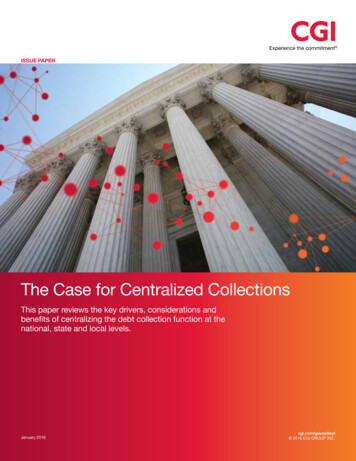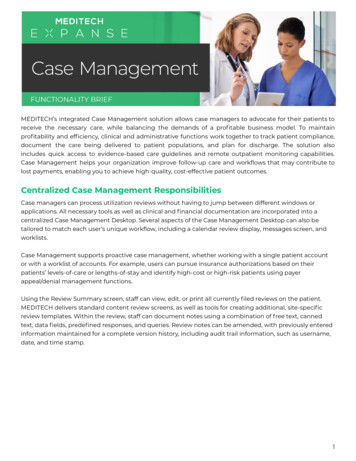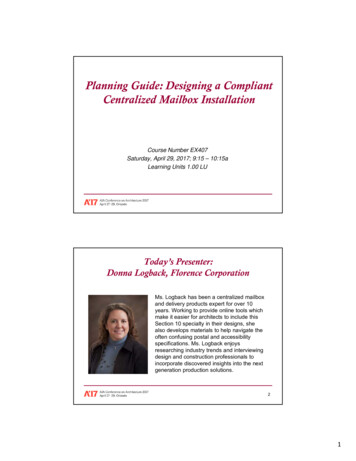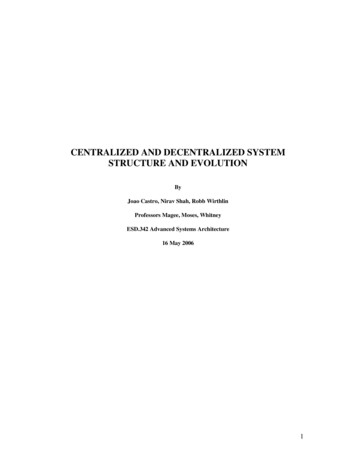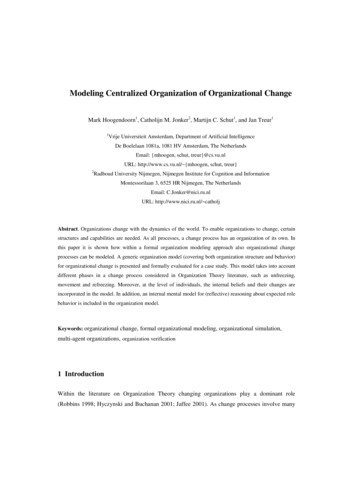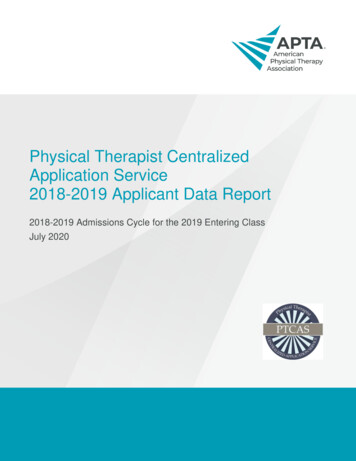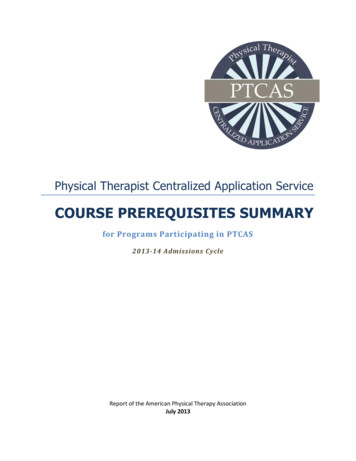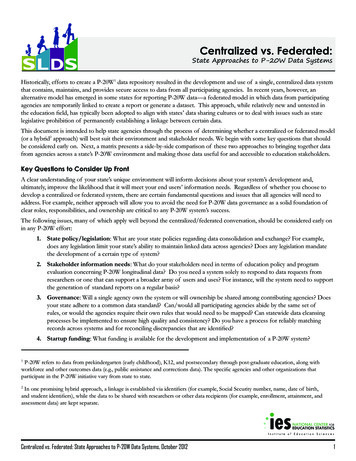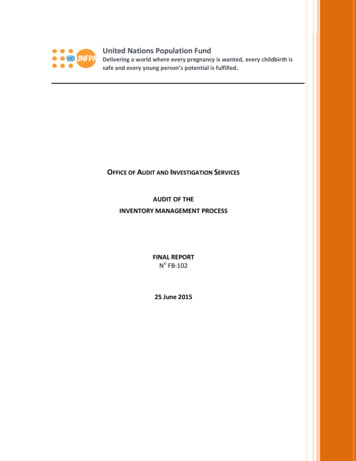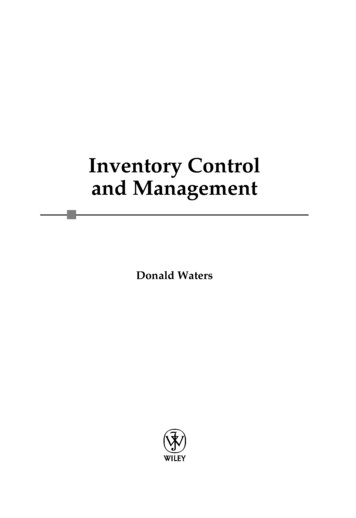
Transcription
Army Regulation 710–1Inventory ManagementCentralizedInventoryManagement ofthe ArmySupply SystemHeadquartersDepartment of the ArmyWashington, DC28 November 2016UNCLASSIFIED
SUMMARY of CHANGEAR 710–1Centralized Inventory Management of the Army Supply SystemThis major revision, dated 28 November 2016-oUpdates responsibilities (para 1-4).oUpdates Integrated Materiel Management and Stockage Policy (paras 2-1 through2-24).oDeletes selected Item Management System-Expanded (formerly chap 3, sectionIII).oUpdates Secondary Item Management Policy (paras 4-1 through 4-17).oUpdates Financial Inventory Management Policy (paras 5-1 through 5-7).oAdds a note to the stratification process (para 5-3).oDeletes Reduced Price Initiative (formerly chap 5 section IV).oRescinds DA Form 1887 (formerly referenced in paras 5-11 and 5-17).oRescinds Army use of DD Form 1138-1 (formerly referenced in para 5-13).oUpdates Army Prepositioned Stocks policy (paras 6-1 through 6-22).oUpdates secondary item metric and data management policies (paras 7-1 through7-3).oUpdates major item identification policy (paras 8-1 through para 8-13,formerly chap 9).oUpdates major item float and factors policy (paras 9-1 through 9-7, formerlychap 8).oUpdates policy for the standard study number process (paras 10-1 through 106).oUpdates data interchange policy (paras 11-1 through 11-4, formerly chap 14).oUpdates major item system map policy (paras 12-1 through 12-3, formerly chap15).oUpdates major item distribution policy (paras 13-1 through 13-18).oUpdates Army aircraft distribution, delivery and disposition policy (paras14-1 through 14-14).oAdds chapter on Divestiture of class VII major items (chap 15).
oDeletes previous chapter, Total Asset Visibility (chap 16).oDeletes previous chapter, Data Quality Assessment Execution Program (chap17).oReplaces Reduced Price Initiative, with Data Interchange (app B).oUpdates DA Form 5661 (app B).oUpdates DA Form 5662 (app B).oReplaces Elements in Computing Cost, with War Reserve Secondary Item Process(app C).oUpdates Materiel Category and Structure Code (app D).oReplaces, Special Program Requirements, with Major Item Management Guide (appE).oUpdates Internal Control and Operational Metrics (app F).oConverts from legacy to Logistics Modernization Program terms and processes(throughout).
*Army Regulation 710–1HeadquartersDepartment of the ArmyWashington, DC28 November 2016Effective 28 December 2016Inventory ManagementCentralized Inventory Management of the Army Supply SystemHistory. This publication is a majorrevision.Summary. This regulation is a consolidation of several regulations that set policy and procedural guidance formanagement of secondary and majoritems, stockage categories, retention levels, financial management, operationaland repair cycle float, Army war reserve,and the Automatic Return Item Program.Applicability. This regulation applies tothe Regular Army, the Army NationalGuard/Army National Guard of the UnitedStates, and the U.S. Army Reserve, unlessotherwise stated. During mobilization, theproponent may modify chapters and policies contained in this regulation.Proponent and exception authority.The proponent of this regulation is theContentsDeputy Chief of Staff, G–4. The proponent has the authority to approve exceptions to this regulation that are consistentwith controlling law and regulations. Theproponent may delegate this approval authority, in writing, to a division chiefwithin the proponent agency or its directreporting unit or field operating agency, inthe grade of Colonel or the civilian equivalent. Activities may request a waiver tothis regulation by providing justificationthat includes a full analysis of the expected benefits and must include formalreview by the activity’s senior legal officer. All waiver requests will be endorsedby the commander or senior leader of therequesting activity and forwarded throughtheir higher headquarters to the policyproponent. Refer to AR 25–30 for specificguidance.Army internal control process. Thisregulation contains internal controls andidentifies key internal controls that mustbe evaluated (see appendix F).Supplementation. Supplementation ofthis regulation and establishment of command and local forms are prohibited without prior approval from the Deputy Chiefof Staff, G–4 (DALO–SPS), Washington,DC 20310–0546.Army Logistics Innovation Agency(LOIA–AP), 5870 21st Street, Building212, Fort Belvoir, VA 22060–5941.Committee management. AR 15–1 requires the proponent to justify establishing/continuing committee(s), coordinatedraft publications, and coordinate changesin committee status with the U.S. ArmyResources and Programs Agency, Department of the Army Committee Management Office (AARP–ZA), 9301 ChapekRoad, Building 1458, Fort Belvoir, VA22060–5527. Further, if it is determinedthat an established "group" identifiedwithin this regulation, later takes on thecharacteristics of a committee, as found inthe AR 15–1, then the proponent will follow all AR 15–1 requirements for establishing and continuing the group as acommitteeDistribution. This publication is available in electronic media only and is intended for command levels C, D, and Efor the Regular Army, the Army NationalGuard/Army National Guard of the UnitedStates, and the U.S. Army Reserve.Suggested improvements. Users areinvited to send comments and suggestedimprovements on DA Form 2028 (Recommended Changes to Publications andBlank Forms) directly to Director, U.S.(Listed by paragraph and page number)Chapter 1Introduction, page 1Section IPurpose, References and Explanation of Abbreviations and Terms, page 1Purpose 1–1, page 1References 1–2, page 1*This regulation supersedes AR 710–1, dated 20 September 2007AR 710–1 28 November 2016UNCLASSIFIEDi
Contents—ContinuedExplanation of abbreviations and terms 1–3, page 1Section IIResponsibilities, page 1Assistant Secretary of the Army (Acquisition, Logistics and Technology) 1–4, page 1Assistant Secretary of the Army (Financial Management and Comptroller) 1–5, page 1Chief, National Guard Bureau 1–6, page 1Deputy Chief of Staff, G–3/5/7 1–7, page 2Deputy Chief of Staff, G–4 1–8, page 2Deputy Chief of Staff, G–8 1–9, page 3Chief, Army Reserve 1–10, page 3The Surgeon General 1–11, page 3Assistant Chief of Staff for Installation Management 1–12, page 4U.S. Army Training and Doctrine Command 1–13, page 4Army Materiel Command 1–14, page 4U.S. Army Special Operations Command 1–15, page 6Chapter 2Integrated Materiel Management and Stockage Policy, page 6Section IIntegrated Materiel Management, page 6Overview 2–1, page 6Integrated materiel management 2–2, page 6Criteria for assigning item management codes 2–3, page 7Interchangeability and substitutability 2–4, page 8Inactive and dormant item management 2–5, page 8Section IINational Stockage Criteria, page 8Stockage review frequency 2–6, page 8Part-numbered items 2–7, page 8Part Number Conversion Program 2–8, page 9Local purchase items 2–9, page 9Management determination logic schematic 2–10, page 9Cost differential 2–11, page 12Numeric stockage objective and insurance items 2–12, page 13Diminishing manufacturing sources and materiel shortages 2–13, page 13Life-of-type buys 2–14, page 13Assignment of the acquisition advice code 2–15, page 14Section IIIMateriel Support Requests, page 14Supply support requests 2–16, page 14Stockage alternatives 2–17, page 17Depot maintenance repair parts support 2–18, page 18Non-consumable item materiel support requests 2–19, page 18Section IVTransfers of Assets, page 18Transfers within the Army 2–20, page 18Transfers between the Army and other Services 2–21, page 18Transfers to allied forces 2–22, page 19Transfers to Federal agencies outside the Department of Defense 2–23, page 19Transfers of cryptological materiel 2–24, page 19iiAR 710–1 28 November 2016
Contents—ContinuedChapter 3Inventory Management Control Programs, page 19Section IComponent Items within Equipment Assemblages, page 19Assemblage and component policy 3–1, page 19Managing assemblages and components 3–2, page 19Section IIPositioning of Stocks, page 20Secondary item assets 3–3, page 20Class V 3–4, page 21Requirements for additional storage facilities and services 3–5, page 22Section IIIAutomatic Return Items, page 22Automatic Return Item List code 3–6, page 22Applicability of automated return items 3–7, page 22Automated return item policy 3–8, page 22Automatic return item objectives 3–9, page 23Automated return item selection criteria 3–10, page 23Field maintenance level retention criteria for automated return items 3–11, page 23Automatic return procedures 3–12, page 23Receipt of automated return items at national/wholesale level 3–13, page 24Credit for return of Supply Management, Army items 3–14, page 24Disposition of automated return item components of major items 3–15, page 24Section IVCentralized Ammunition Management, page 24Overview 3–16, page 24Concept 3–17, page 24Objectives 3–18, page 25Responsibilities (Outside and Inside the Continental United States) 3–19, page 25Execution (Outside and Inside the Continental United States) 3–20, page 25Reports 3–21, page 27Automated tracking 3–22, page 27Section VSpecial Commodity Control Programs, page 28Obsolete or excess end items and threat representative targets 3–23, page 28Management of reusable containers 3–24, page 29Section VIRecycling Excess Materiel Inventory/Reclamation at the National/wholesale Level, page 32Defense Logistics Agency Disposition Services reissue process 3–25, page 32Introduction to reclamation 3–26, page 32Reclamation roles 3–27, page 32Reclamation policy 3–28, page 32Reclamation funding 3–29, page 33National/wholesale inventory control point functions for routine reclamation 3–30, page 33Supply functions at the depot for routine reclamation 3–31, page 36Life Cycle Management Command functions for priority reclamation 3–32, page 36Supply functions at the depot for priority reclamation 3–33, page 37DA Form 7420, Parts Reclamation List 3–34, page 37AR 710–1 28 November 2016iii
Contents—ContinuedChapter 4Secondary Item Requirements, Inventory and Supply Chain Management, page 40Section IRequirements and Demand Forecasting, page 40Inventory categories, approval thresholds and data retention 4–1, page 40Demand planning, supply planning and data integrity 4–2, page 42Coverage profile and procurement/repair lead-times 4–3, page 42Section IIRetention Management, Credit Policy and Supply Chain Metrics/Parameters, page 43National/wholesale retention policy 4–4, page 43Credit for assets returned to the national/wholesale echelon 4–5, page 44Global planning parameters 4–6, page 44Section IIIAcquisition Strategies and Supply Chain Management, page 44Acquisition strategies 4–7, page 44Supply chain management 4–8, page 46Section IVProvisioning and Phase-Out Segments of the Item Lifecycle, page 47Provisioning phase of the item lifecycle 4–9, page 47Phase-out segment of the item lifecycle 4–10, page 47Interim contractor support 4–11, page 48Section VOther Centralized Secondary Item Inventory Management Topics, page 48Supply performance analyzer 4–12, page 48Requirements computation for spare engines 4–13, page 48Item unique identification 4–14, page 48Non-Army Managed Item Program 4–15, page 48Counterfeit parts 4–16, page 49Management of other item manager assets on Army records 4–17, page 49Chapter 5Financial Inventory Management, page 50Scope 5–1, page 50Materiel Category Structure Code 5–2, page 50The stratification process 5–3, page 50Special instructions on reparable items 5–4, page 50Central secondary item stratification for budget 5–5, page 51Objectives of reporting inventory valuations 5–6, page 53Inventory valuation reports 5–7, page 53Chapter 6Management of Army Prepositioned Stocks, page 55Section IOverview, page 55Introduction 6–1, page 55Army Prepositioned Stocks roles 6–2, page 56Security classification 6–3, page 58Section IIRelease and Use of Army Prepositioned Stocks, page 59ivAR 710–1 28 November 2016
Contents—ContinuedOverview and guidance 6–4, page 59Equipment sourcing and funding of Army Prepositioned Stocks 6–5, page 61Replacement of Army Prepositioned Stock Materiel 6–6, page 61Section IIIArmy Prepositioned Stocks Unit Sets, page 62Program 6–7, page 62Requirements determination 6–8, page 62Readiness reporting 6–9, page 62Unit deployments 6–10, page 63Section IVArmy Prepositioned Stock Operational Projects, page 63Concept and overview 6–11, page 63Request and revision procedures 6–12, page 63Roles and responsibilities 6–13, page 63Acquiring assets 6–14, page 64Canceling 6–15, page 64Section VArmy War Reserve Sustainment, page 65Management roles 6–16, page 65Requirements determination 6–17, page 65Types of major item sustainment 6–18, page 65Positioning objectives for storing Army War Reserve Sustainment 6–19, page 66Integrated Materiel Management 6–20, page 66Section VIWar Reserve Stocks for Allies/ Activity Sets, page 66Overview and guidance 6–21, page 66Overview and guidance 6–22, page 67Chapter 7Supply Chain Metrics and Data Management, page 67Performance requirements 7–1, page 67LCMC data management 7–2, page 74Data Quality Assessment Program 7–3, page 74Chapter 8Major Item Overview, page 75Section IMajor Item Identification, page 75Major item criteria 8–1, page 75Major item designation 8–2, page 75Type classification code 8–3, page 76Section IIForce Structuring, page 77Authorization and allowance documents 8–4, page 77Structure and Manpower Allocation System 8–5, page 77The Army Authorization Documents System 8–6, page 77Tables of organization and equipment 8–7, page 77Basis-of-issue plan 8–8, page 78Updating and maintaining authorization and allowance documents 8–9, page
Centralized Inventory Management of the Army Supply System This major revision, dated 28 November 2016--o Updates responsibilities (para 1-4). o Updates Integrated Materiel Management and Stockage Policy (paras 2-1 through 2-24). o Deletes selected Item Management System-Expanded (formerly chap 3,
